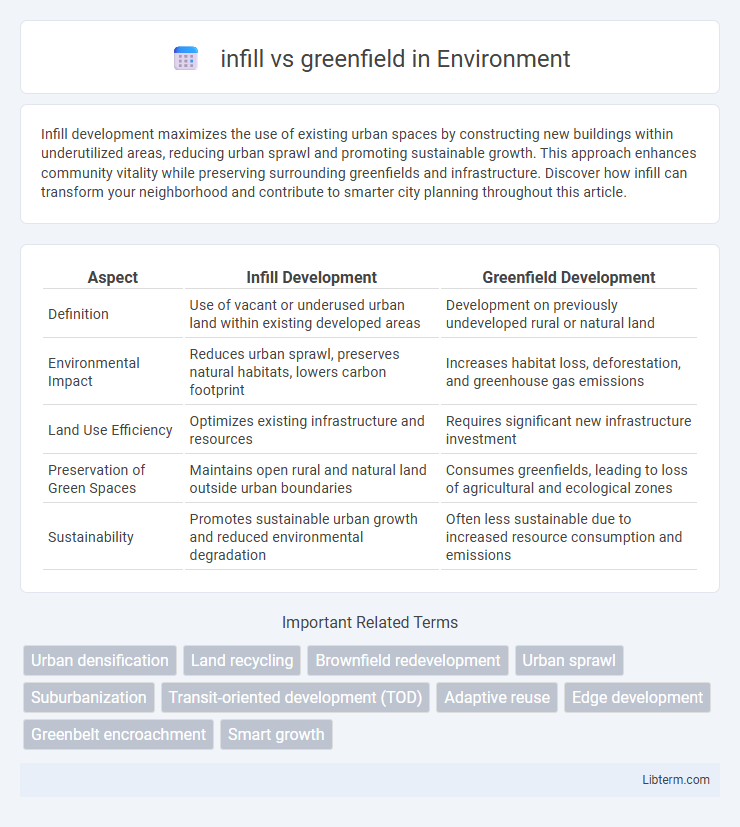Infill development maximizes the use of existing urban spaces by constructing new buildings within underutilized areas, reducing urban sprawl and promoting sustainable growth. This approach enhances community vitality while preserving surrounding greenfields and infrastructure. Discover how infill can transform your neighborhood and contribute to smarter city planning throughout this article.
Table of Comparison
| Aspect | Infill Development | Greenfield Development |
|---|---|---|
| Definition | Use of vacant or underused urban land within existing developed areas | Development on previously undeveloped rural or natural land |
| Environmental Impact | Reduces urban sprawl, preserves natural habitats, lowers carbon footprint | Increases habitat loss, deforestation, and greenhouse gas emissions |
| Land Use Efficiency | Optimizes existing infrastructure and resources | Requires significant new infrastructure investment |
| Preservation of Green Spaces | Maintains open rural and natural land outside urban boundaries | Consumes greenfields, leading to loss of agricultural and ecological zones |
| Sustainability | Promotes sustainable urban growth and reduced environmental degradation | Often less sustainable due to increased resource consumption and emissions |
Understanding Infill and Greenfield Development
Infill development maximizes the use of existing urban spaces by redeveloping underutilized or vacant parcels within established neighborhoods, promoting sustainability and reducing urban sprawl. Greenfield development involves building on previously undeveloped land, often at the urban fringe, allowing for expansive new projects but potentially increasing infrastructure costs and environmental impact. Understanding the trade-offs between infill and greenfield development is crucial for effective urban planning and resource management.
Key Differences Between Infill and Greenfield Projects
Infill projects involve developing unused or underutilized parcels within existing urban areas, optimizing land use and infrastructure while reducing urban sprawl. Greenfield projects focus on building in previously undeveloped, often rural or peripheral lands, allowing more design flexibility but requiring significant new infrastructure investment. Key differences include location constraints, infrastructure availability, environmental impact, and regulatory challenges, with infill projects prioritizing sustainability and urban renewal versus greenfield's emphasis on expansion and customization.
Environmental Impacts: Infill vs Greenfield
Infill development reduces environmental impacts by minimizing urban sprawl and preserving natural habitats compared to greenfield projects that often lead to habitat destruction and increased carbon emissions. Utilizing existing infrastructure in infill areas lowers energy consumption and water runoff, promoting sustainable urban growth. Greenfield developments typically require extensive land alteration, contributing to soil erosion and loss of biodiversity, which significantly impacts local ecosystems.
Economic Considerations for Urban Expansion
Infill development leverages existing infrastructure and public services, reducing upfront costs and promoting efficient land use for urban expansion. Greenfield projects require significant investment in new infrastructure, often resulting in higher initial economic outlays and extended timelines to achieve returns. Economic considerations favor infill for its potential to stimulate local economies through revitalization while minimizing environmental remediation expenses.
Infrastructure and Public Services Demands
Infill development often leverages existing infrastructure such as roads, sewage systems, and utilities, reducing the need for extensive new public service investments and promoting efficient urban resource use. Greenfield projects typically require building new infrastructure from scratch, which can increase costs and place a higher demand on public services like schools, transit, and emergency response systems. Prioritizing infill development supports sustainable growth by minimizing environmental impact and optimizing municipal service delivery capacities.
Community and Social Implications
Infill development enhances community cohesion by revitalizing underused urban areas, promoting walkability, and supporting existing infrastructure, thus fostering stronger neighborhood networks. Greenfield development, often on the outskirts of cities, can lead to social fragmentation and reduced access to amenities due to its reliance on new infrastructure and limited integration with established communities. Prioritizing infill projects promotes equitable access to services, reduces urban sprawl, and supports social sustainability by maintaining diverse, connected, and vibrant urban populations.
Regulatory and Zoning Challenges
Infill development faces complex regulatory and zoning challenges due to existing land use restrictions, historic preservation rules, and stricter environmental impact assessments within established urban areas. Greenfield projects often benefit from more flexible zoning regulations and fewer legacy constraints, enabling easier compliance with modern planning standards. However, local governments may impose growth boundaries or environmental protections on greenfield sites to prevent sprawl and preserve natural resources.
Sustainability and Long-term Urban Growth
Infill development maximizes sustainability by repurposing underutilized urban areas, reducing urban sprawl and preserving natural landscapes. Greenfield projects, often situated on undeveloped land, can lead to habitat disruption and increased carbon footprints from prolonged transportation needs. Prioritizing infill supports long-term urban growth through efficient infrastructure use and enhanced community resilience.
Case Studies: Successful Infill and Greenfield Projects
Case studies of successful infill projects highlight urban sites transformed into high-density mixed-use developments, such as the Pearl District in Portland, which revitalized underutilized industrial land into vibrant residential and commercial spaces. Greenfield examples include the master-planned community of The Woodlands in Texas, designed on previously undeveloped land to balance residential, commercial, and recreational uses with sustainability principles. These projects demonstrate distinct planning approaches: infill maximizes existing infrastructure, while greenfield allows for comprehensive design from the ground up, influencing urban growth patterns and sustainability outcomes.
Choosing the Right Approach for Urban Development
In urban development, choosing between infill and greenfield approaches depends on factors like land availability, environmental impact, and infrastructure costs. Infill development maximizes use of existing urban areas, reduces sprawl, and leverages existing utilities, making it ideal for sustainable growth in densely populated cities. Greenfield development suits expanding cities needing new residential or commercial zones but requires careful environmental assessment and higher infrastructure investment.
infill Infographic

 libterm.com
libterm.com